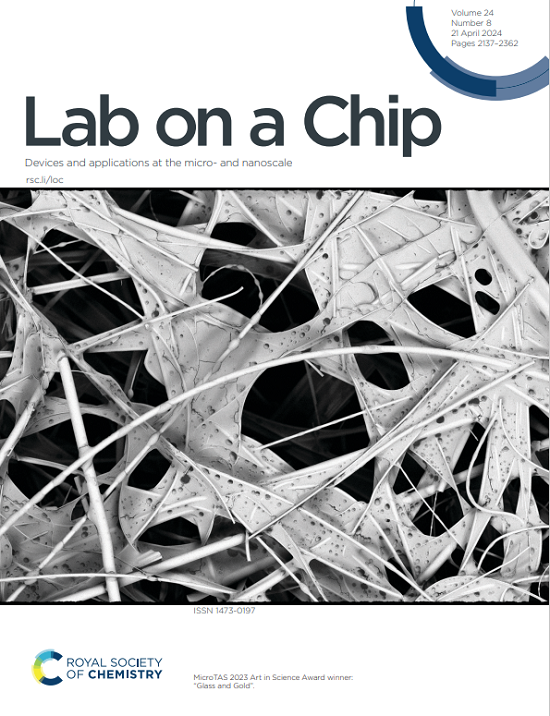可调谐液滴分裂的微弹性流体学。
IF 6.1
2区 工程技术
Q1 BIOCHEMICAL RESEARCH METHODS
引用次数: 0
摘要
液滴微流体是一种变革性的技术,用于在不混相载体流体中产生和操纵液滴。这项技术跨越了许多应用领域,包括生物医药、食品和饮料加工以及材料合成。液滴分裂是液滴微流体中的一项关键任务,对于在芯片实验室应用中多个分析之间测量流体样品至关重要。用t型结进行被动液滴分裂是一种直接而简单的方法。然而,实现可变液滴尺寸通常需要许多具有不同通道尺寸和复杂通道排列的设备。为了解决这一限制,我们提出了一种完全灵活和可拉伸的微流体技术,用于可调液滴分裂。通过外部拉伸t型结,通道臂的尺寸可以实时动态改变,从而精确控制子液滴的体积和比例。我们通过理论分析、数值模拟和实验评估研究了拉伸对通道尺寸、水力阻力和液滴分裂行为的影响。结果显示在零拉伸时对称分裂,并且在高达4 mm的器件拉伸(~ 16%的应变)下可调谐子液滴体积比高达约4。此外,我们还证明了该技术在颗粒分选中的适用性,通过调节装置的拉伸,可以不对称地分裂包裹颗粒的母滴。最后,我们展示了微藻在母滴内的封装以及微藻在子滴中的浓度随拉伸的调节。这种创新的方法为可调液滴分裂提供了一种通用和直接的方法,提供了对液滴尺寸的实时控制,而无需复杂或多个微流体设计。微弹性流体技术的这一进步为高通量和可定制的基于液滴的分析开辟了新的可能性。本文章由计算机程序翻译,如有差异,请以英文原文为准。
Micro elastofluidics for tuneable droplet splitting.
Droplet microfluidics is a transformative technology for generating and manipulating droplets in an immiscible carrier fluid. This technology spans many application areas, including biomedicine, food and beverage processing, as well as material synthesis. Droplet splitting is a key task in droplet microfluidics, which is essential for metering fluid samples between multiple assays in lab-on-a-chip applications. Passive droplet splitting with a T-junction is a straightforward and simple method. However, achieving variable droplet sizes typically requires numerous devices with different channel dimensions and complex channel arrangements. To address this limitation, we proposed a fully flexible and stretchable microfluidic technology for tunable droplet splitting. By externally stretching the T-junction, the dimensions of the channel arms can be dynamically altered in real time, allowing precise control over daughter droplet volumes and ratios. We investigated the effects of stretching on channel dimensions, hydraulic resistance, and droplet-splitting behaviour by theoretical analysis, numerical modelling, and experimental evaluations. The results revealed symmetric splitting at zero stretching and a tunable daughter droplet volume ratio up to approximately 4 with up to 4 mm device stretching (∼16% strain). Furthermore, we demonstrated the suitability of this technology for particle sorting, where particle-encapsulating mother droplets were asymmetrically split by adjusting device stretching. Finally, we demonstrated the encapsulation of microalgae within mother droplets and the tuning of microalgae concentration in the daughter droplets with stretching. This innovative approach provides a versatile and straightforward method for tunable droplet splitting, offering real-time control over droplet sizes without complex or multiple microfluidic designs. This advancement in micro elastofluidic technology opens up new possibilities for high-throughput and customisable droplet-based assays.
求助全文
通过发布文献求助,成功后即可免费获取论文全文。
去求助
来源期刊

Lab on a Chip
工程技术-化学综合
CiteScore
11.10
自引率
8.20%
发文量
434
审稿时长
2.6 months
期刊介绍:
Lab on a Chip is the premiere journal that publishes cutting-edge research in the field of miniaturization. By their very nature, microfluidic/nanofluidic/miniaturized systems are at the intersection of disciplines, spanning fundamental research to high-end application, which is reflected by the broad readership of the journal. Lab on a Chip publishes two types of papers on original research: full-length research papers and communications. Papers should demonstrate innovations, which can come from technical advancements or applications addressing pressing needs in globally important areas. The journal also publishes Comments, Reviews, and Perspectives.
 求助内容:
求助内容: 应助结果提醒方式:
应助结果提醒方式:


